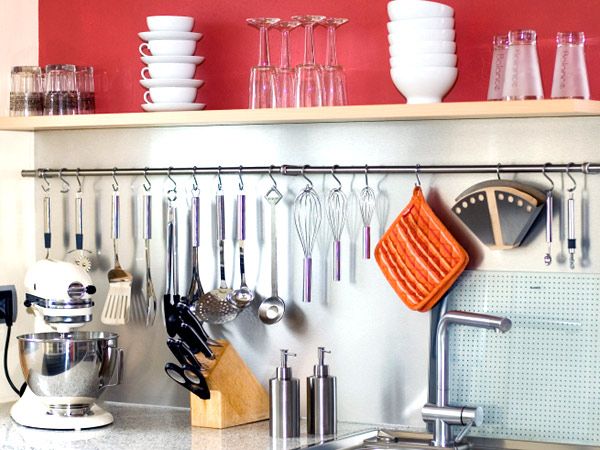
One reason things pile up on counters, tables, and floors is because they have no “home.”
I love to organise! Okay, that may be overstating things a bit. Let’s rephrase: I love to be organised.
I think all of us love to be organised, whether we admit it or not. Let’s face it; there is so much less stress in life when things aren’t a complete debacle. You may not realise it, but a messy and cluttered home can have a negative impact on your goals and over-all sense of empowerment. When your house is in order: organised, peaceful, and reflecting your sense of “style”, it creates an atmosphere of safety. No matter how stressed you may feel in situations away from home, you know you have a safe place to find refuge.
Having a tidy house keeps me happy and calm. When my space is organised and clear, I don’t panic when people drop by unannounced (which is a lot of times), I’m not wasting time searching for lost items, I arrive on time (well, almost on time), and I have more time to have fun with my family.
Every January, I always seem to get the bug to revise my “systems” because after a while, things just seem like they aren’t working. Being (somewhat) organised is practically a law for moms. Over the years I have learnt a few handy tips that might help you tame the chaos in your home, and most importantly, get time back in your day! Anyhow, if you are a mom or even a homemaker, if this time of year also makes you feel the need to get more organised, this post is for you!
Not everything may work for you, your family, or your home, but if even a few ideas help to make your life a little less hectic, then all the time I spent on this article will be worth it! 🙂
1. Find a place for every item.
One reason things pile up on counters, tables, and floors is because they have no “home.” If it’s something you use frequently, make sure the storage place is easy to access. If you need to reach to a high shelf and take down your daily towels just so you can return the towel to its ‘home,’ odds are it’s going to get hanged at any hook it finds in the house.
2. Play clutter cop.
The better you are about keeping things out of your home, the less likely things will pile up inside. Take freebies. It’s nice to get a T-shirt, coffee mug or the complimentary hotel toiletries (well, the bottles are cute to look at); but will you really use it? If not, decline it. Or let’s say you’re a voracious reader. You could buy books — but why not borrow (and return!) them from your public library? And take a minute to opt out of mailers from credit card companies and other direct marketers. Bottom line? Always look for ways to block unneeded items before they cross your threshold.
3. Do some detective work.
Periodically scan your home for clutter hot spots, and spend some time figuring out why stuff accumulates there. Often, it’s not what you think. Take the stack of magazines and newspapers next to your coffee table. People often assume that magazines / newspapers pile up because after reading them it’s too much work to put them in the cabinet for recycle items. But many a time the family members hate that because it means having to open the cabinet just so all those plastic containers or more piles of papers rain down on them. Empty the cabinet on a more regular basis. Once you understand the problem, you’ll find it easy to devise a solution.
4. Dump duplicates.
Why have two nonstick spatulas when one is enough? Why have six hairbrushes or 17 coffee mugs? Anytime you get something new, get rid of something like it that is old.
5. Beware of nostalgia.
If you’re a doting parent, it’s not easy to discard a child’s creation, whether it’s pastel drawings from the second grade or that cooler-sized medieval castle. But if you’re serious about minimising clutter, you must. I recommend taking a picture of your child with the creation, and letting that be your keepsake. After all what would you rather have in 30 years — a photo of that castle, or the insect-infested castle itself?
6. Weed out your wardrobe.
Odds are your clothes closet is chockablock with clothes that are rarely worn. It’s a classic case of the 80:20 rule: we wear 20% of our clothes 80% of the time. One key to de-cluttering is getting rid of things, not simply rearranging them. Tidying up is not the same as organising. I tried what was more like a reality check on my wardrobe last year (it might work for you too). Turn the hangers in the same direction. When you wear something, turn the hanger around. After a year, you’ll know what you haven’t worn; time to pass them on.
7. Stick to a schedule.
Some spaces, like kitchen counters, need daily de-cluttering. Others can be tackled weekly or monthly. When that time comes, be systematic. Take all the items in a defined area (a cabinet, a desk drawer), and spread them out so you can see what you’re facing. If you’re de-cluttering the drawer where you keep kitchen utensils, for example, spread them on the counter, and then sort into two piles: utensils you use regularly and those you don’t use. Be patient; effective de-cluttering takes time.
Whatever happens, try not to feel embarrassed about clutter. It’s important to remember that organising need not be perfect, and that “good enough” really is okay. “When you’re on your deathbed, you’re not going to wish that you had found the perfect organising container,” says my mom when I act like I have a stroke of OCD. The important thing is being able to spend more time with family and friends. De-cluttering helps make that happen.
The important thing to remember here is that keeping your house tidy is an ongoing process – it’s going to need work every day. Now again that is an issue most of us face – “Remembering”. In our fast pace life when we are simultaneously doing things we tend to forget about the smaller or unimportant things. And then struggle to find them back. Most of the times we lose things because we don’t put them back where we found them.
More On >> Home Decor




